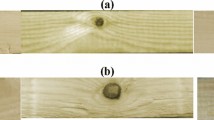Abstract
This paper proposes a fast, accurate and automatic method to segment wood knots from images obtained by X-Ray Computed Tomography scanner. The wood knot segmentation is a classical problem where the most popular segmentation techniques produce unsatisfactory results. In a previous work, a method was developed to detect knot areas and an approach was proposed to segment the knots. However this last step is not entirely satisfactory in the presence of sapwood. This paper presents a novel approach for knot segmentation, based on the original idea considering slices tangential to the growth rings. They allow to track the knot from the log pith to the bark. Knots are then segmented by detecting discrete ellipses in each slice. A complete implementation is proposed on the TKDetection software available online.
Access this chapter
Tax calculation will be finalised at checkout
Purchases are for personal use only
Similar content being viewed by others
Notes
- 1.
\(-900\) (in Hounsfield Unit) corresponds to a wood density of 100kg/m\(^3\).
References
DGtal: digital geometry tools and algorithms library. http://dgtal.org
Aguilera, C., Sanchez, R., Baradit, E.: Detection of knots using X-ray tomographies and deformable contours with simulated annealing. Wood Res. 53, 57–66 (2008)
Andreu, J.-P., Rinnhofer, A.: Modeling knot geometry in norway spruce from industrial CT images. In: Bigun, J., Gustavsson, T. (eds.) SCIA 2003. LNCS, vol. 2749, pp. 786–791. Springer, Heidelberg (2003)
Boukadida, H., Longuetaud, F., Colin, F., Freyburger, C., Constant, T., Leban, J.M., Mothe, F.: Pithextract: a robust algorithm for pith detection in computer tomography images of wood - application to 125 logs from 17 tree species. Comput. Electr. Agric. 85, 90–98 (2012)
Cleveland, W.S.: Robust locally weighted regression and smoothing scatterplots. JASA 74, 829–836 (1979)
Coeurjolly, D., Lachaud, J.-O., Levallois, J.: Integral based curvature estimators in digital geometry. In: Gonzalez-Diaz, R., Jimenez, M.-J., Medrano, B. (eds.) DGCI 2013. LNCS, vol. 7749, pp. 215–227. Springer, Heidelberg (2013). doi:10.1007/978-3-642-37067-0_19
Couprie, C., Grady, L., Najman, L., Talbot, H.: The power watershed algorithm c/c++ code. http://sourceforge.net/projects/powerwatershed/
Couprie, C., Grady, L., Najman, L., Talbot, H.: Power watersheds: a unifying graph-based optimization framework. IEEE PAMI 33(7), 1384–1399 (2010)
Kerautret, B., Lachaud, J.O.: Curvature estimation along noisy digital contours by approximate global optimization. PR 42(10), 2265–2278 (2009)
Krähenbühl, A., Kerautret, B., Feschet, F.: Knot Detection from Accumulation Map by Polar Scan. In: Barneva, P.R., et al. (eds.) IWCIA 2015. LNCS, vol. 9448, pp. 352–362. Springer, Heidelberg (2015). doi:10.1007/978-3-319-26145-4_26
Krähenbühl, A.: TKDetection (2012). https://github.com/akrah/TKDetection/
Krähenbühl, A., Kerautret, B., Debled-Rennesson, I.: Knot segmentation in noisy 3D images of wood. In: Gonzalez-Diaz, R., Jimenez, M.-J., Medrano, B. (eds.) DGCI 2013. LNCS, vol. 7749, pp. 383–394. Springer, Heidelberg (2013)
Krähenbühl, A., Kerautret, B., Debled-Rennesson, I., Longuetaud, F., Mothe, F.: Knot detection in X-Ray CT images of wood. In: Bebis, G., Boyle, R., Parvin, B., Koracin, D., Fowlkes, C., Wang, S., Choi, M.-H., Mantler, S., Schulze, J., Acevedo, D., Mueller, K., Papka, M. (eds.) ISVC 2012, Part II. LNCS, vol. 7432, pp. 209–218. Springer, Heidelberg (2012)
Nordmark, U.: Value recovery and production control in the forestry-wood chain using simulation technique. Ph.D. thesis, Luleå University of Technology (2005)
Roussel, J.R., Mothe, F., Krähenbühl, A., Kerautret, B., Debled-Rennesson, I., Longuetaud, F.: Automatic knot segmentation in CT images of wet softwood logs using a tangential approach. Comput. Electr. Agric. 104, 46–56 (2014)
Van Aken, J.: An efficient ellipse-drawing algorithm. IEEE Comput. Graph. Appl. 4, 24–35 (1984)
Author information
Authors and Affiliations
Corresponding authors
Editor information
Editors and Affiliations
Rights and permissions
Copyright information
© 2016 Springer International Publishing AG
About this paper
Cite this paper
Krähenbühl, A., Roussel, JR., Kerautret, B., Debled-Rennesson, I., Mothe, F., Longuetaud, F. (2016). Robust Knot Segmentation by Knot Pith Tracking in 3D Tangential Images. In: Chmielewski, L., Datta, A., Kozera, R., Wojciechowski, K. (eds) Computer Vision and Graphics. ICCVG 2016. Lecture Notes in Computer Science(), vol 9972. Springer, Cham. https://doi.org/10.1007/978-3-319-46418-3_52
Download citation
DOI: https://doi.org/10.1007/978-3-319-46418-3_52
Published:
Publisher Name: Springer, Cham
Print ISBN: 978-3-319-46417-6
Online ISBN: 978-3-319-46418-3
eBook Packages: Computer ScienceComputer Science (R0)




